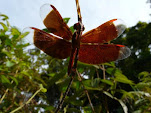Being a sunny day and a mid-afternoon count in mid-March, I wasn't expecting a great deal out of the survey, and add to the mix the fact that today was Mothering Sunday - and you can see that there was plenty of potential for people to be out and about on the beach. Sure enough, when I arrived the beach was packed to the gills; a few hardy souls even in the water. The northerly wind was keeping the swell down to nothing though, so checking the sea was a cinch - and there were only just more birds than waves. A measly half-dozen Great Crested Grebes was it...
On down to the pond beside the visitor centre, where in addition to a fine drake Teal with three females, a Chiffchaff sang lustily from the high willows, whilst another called quietly in the willows just in front of me. Buoyed by this sign of a rapidly-turning season I headed on to the main wader roost. Nothing much along the seafront - two Knot roosting on a groyne the best of it - and plenty of people walking the beach even this far up. The tide was still some way off the bight, so after a rapid scan of the waders there I headed off to check the end of the sandspit.
Here was another sign of spring arriving: a fine male Wheatear flipped off ahead of me, from behind a mix of stone-grey, black and white, then a rich apricot-buff when he turned to check whether I was still walking his way. The point proved as enduringly birdless as the rest of the beach, and so I headed back towards the main roost along the riverside. An immediate reward came in the shape of a small flock of Sanderling, still in their silver-grey plumage and without any hint of the freckly ginger-rust they will develop soon for their summer plumage, who skimmed along the waterline and landed within a couple of metres of me. Heads bobbing with initial alarm, they soon settled down and began trotting along the water's edge, dipping erratically to grab small invertebrates as the waves washed across the sand.
 |
| Sanderling, trotting gently along the sands. Perhaps having wintered in South Africa, and on the way to the high Arctic to breed. |
 |
| Brent Geese - the last few lingering on the Exe will soon be heading off to the tundra of Arctic Russia, via the Waddensee - a massive area of intertidal mud between Germany and Denmark. |
True to spring weather form, the rain began as I headed back to the car, so only a cursory check for interesting plants on the way back - one day I will spend little more time looking through the dune grassland to see what I can find lurking...



1 comment:
Went on Monday bit quieter than Sunday . Had hoped to see the sand crocus but too early but lots of whitlow grass in flower. Hope Sabina is ok.
Post a Comment